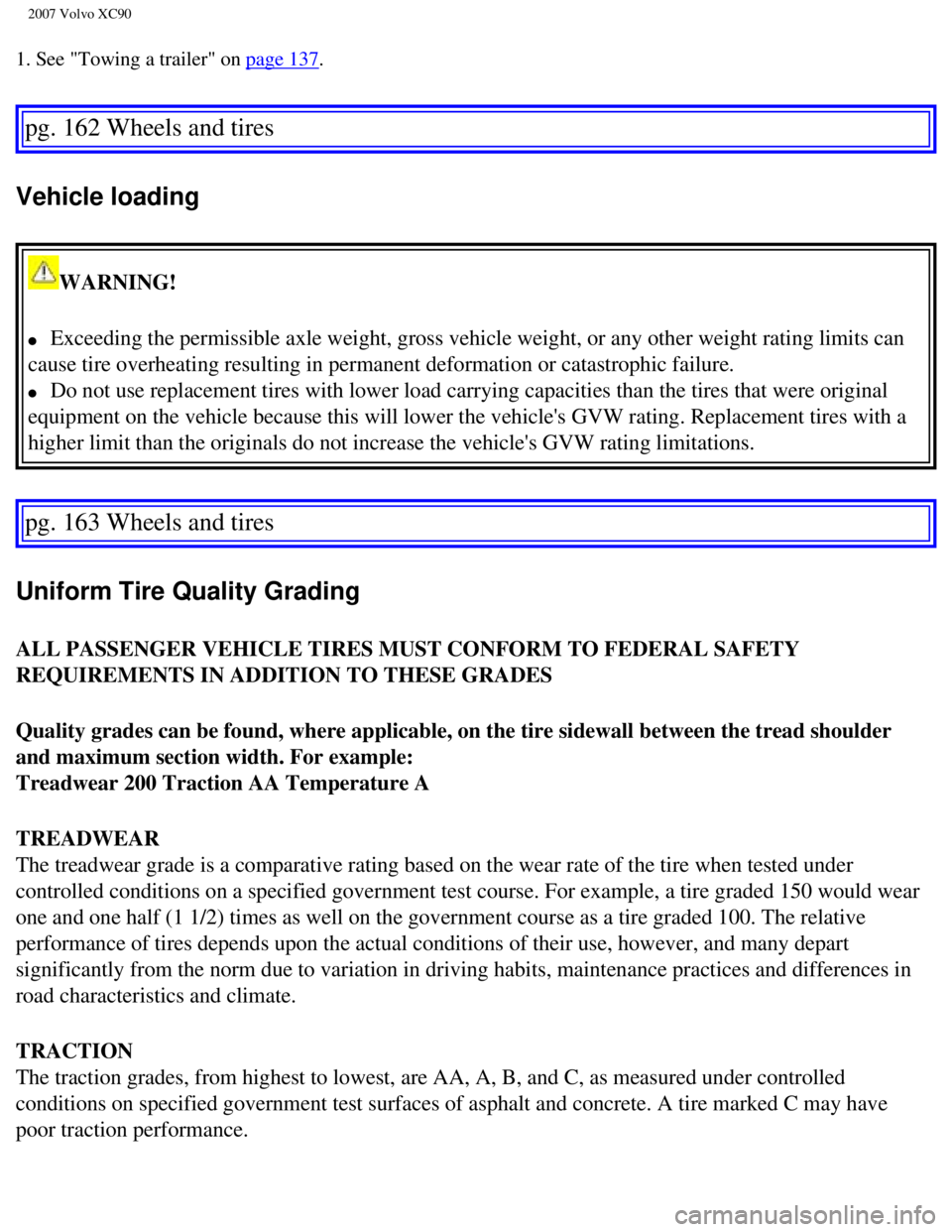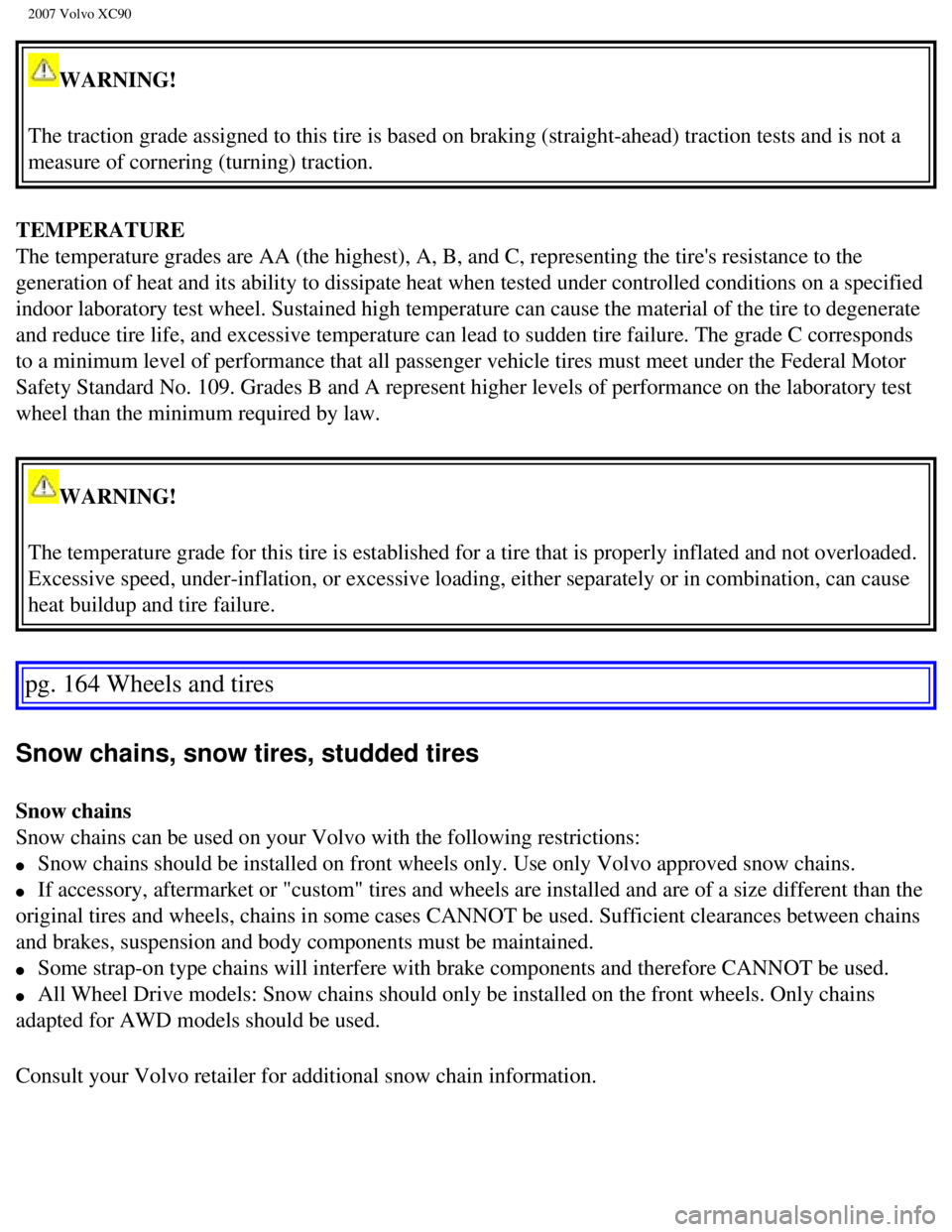2007 VOLVO XC90 tires
[x] Cancel search: tiresPage 162 of 268

2007 Volvo XC90
- Add air to reach the recommended air pressure.
- Replace the valve cap.
- Repeat this procedure for each tire, including the spare.
- Visually inspect the tires to make sure there are no nails or other ob\
jects embedded that could puncture
the tire and cause an air leak.
- Check the sidewalls to make sure there are no gouges, cuts, bulges or \
other irregularities.
NOTE:
l If you overfill the tire, release air by pushing on the metal stem in th\
e center of the valve. Then
recheck the pressure with your tire gauge.
l Some spare tires require higher inflation pressure than the other tires.\
Consult the tire inflation table
on
page 154 or see the inflation pressure placard.
pg. 154 Wheels and tires
Tire inflation pressure tables - U.S. models
The following tire pressures are recommended by Volvo for your vehicle. \
Refer to the tire inflation
placard for information specific to the tires installed on your vehicle \
at the factory.
Cold tire pressures up to five persons
Tire size Front, psi
(kPa) Rear, psi (kPa)
XC90
235/65R17
235/60R18
255/50R19 36 (250)
36 (250)
Temporary spare tire
T155/85R18 61 (420)
61 (420)
Load ratings
The load ratings in the tables above translate as follows:
91 = 1365 lbs (615 kg), 93 = 1433 lbs (650 kg), 99 = 1709 lbs (755 \
kg)
Speed ratings
The speed ratings in the tables translate as follows:
M = 81 mph (130 km/h), V= 149 mph (240 km/h), W= 168 mph (270 km/h)\
See also
page 159 for an explanation of the designations on the sidewall of the tire.
file:///K|/ownersdocs/2007/2007_XC90/07xc90_07.htm (6 of 23)12/30/2006\
5:53:47 PM
Page 163 of 268

2007 Volvo XC90
pg. 155 Wheels and tires
Tire inflation pressure tables - Canadian models
The following tire pressures are recommended by Volvo for your vehicle. \
Refer to the tire inflation
placard for information specific to the tires installed on your vehicle \
at the factory.
Tire size Cold tire pressures
up to five persons psi (kPa) Optional pressure
up to three persons psi (kPa)
FrontRear Front Rear
225/70R16
235/65R17
235/60R18
255/50R19 39 (270
39 (270) 32 (220) 32 (220)
Temporary spare tire
T155/85R18 61 (420)
61 (420) 61 (420) 61 (420)
pg. 156 Wheels and tires
Tire Pressure Monitoring System (TPMS) - option
The tire pressure monitoring system uses sensors mounted in the tire val\
ves to check inflation pressure
levels. When the vehicle is moving at a speed of approximately 20 mph (\
30 km/h) or faster, these
sensors transmit inflation pressure data to a receiver located in the ve\
hicle.
USA - FCC ID: MRXTG315AM04
This device complies with part 15 of the FCC rules. Operation is subject\
to the following conditions:
(1) This device may not cause harmful interference, and (2) this dev\
ice must accept any interference
received, including interference that may cause undesired operation.
When low inflation pressure is detected, TPMS will light up the tire pre\
ssure warning light (
) (also
referred to as a telltale) in the instrument panel, and will display a \
message in the text window. The
wording of this message is determined by the degree of inflation pressur\
e loss.
NOTE: If a fault occurs in TPMS, the tire pressure warning light will flash f\
or approximately 1 minute
and TIRE PRESS SYST SERVICE REQUIRED will be displayed.
file:///K|/ownersdocs/2007/2007_XC90/07xc90_07.htm (7 of 23)12/30/2006\
5:53:47 PM
Page 164 of 268

2007 Volvo XC90
Each tire, including the spare (if provided), should be checked monthl\
y when cold and inflated to the
inflation pressure recommended by the vehicle manufacturer on the vehicl\
e placard or tire inflation
pressure label. (If your vehicle has tires of a different size than the\
size indicated on the vehicle placard
or tire inflation pressure label, you should determine the proper tire i\
nflation pressure for those tires.)
As an added safety feature, your vehicle has been equipped with a tire p\
ressure monitoring system
(TPMS) that illuminates a low tire pressure telltale when one or more \
of your tires is significantly under-
inflated. Accordingly, when the low tire pressure telltale illuminates, \
you should stop and check your
tires as soon as possible, and inflate them to the proper pressure. Driv\
ing on a significantly under-
inflated tire causes the tire to overheat and can lead to tire failure. \
Under-inflation also reduces fuel
efficiency and tire tread life, and may affect the vehicle's handling an\
d stopping ability.
Please note that the TPMS is not a substitute for proper tire maintenanc\
e, and it is the driver's
responsibility to maintain correct tire pressure, even if under-inflatio\
n has not reached the level to trigger
illumination of the TPMS low tire pressure telltale.
Your vehicle has also been equipped with a TPMS malfunction indicator to\
indicate when the system is
not operating properly. The TPMS malfunction indicator is combined with \
the low tire pressure telltale.
When the system detects a malfunction, the telltale will flash for appro\
ximately one minute and then
remain continuously illuminated. This sequence will continue upon subseq\
uent vehicle start-ups as long
as the malfunction exists. When the malfunction indicator is illuminated\
, the system may not be able to
detect or signal low tire pressure as intended. TPMS malfunctions may oc\
cur for a variety of reasons,
including the installation of replacement or alternate tires or wheels o\
n the vehicle that prevent the
TPMS from functioning properly. Always check the TPMS malfunction tellta\
le after replacing one or
more tires or wheels on your vehicle to ensure that the replacement or a\
lternate tires and wheels allow
the TPMS to continue to function properly.
NOTE:
l TPMS indicates low tire pressure but does not replace normal tire mainte\
nance. For information on
correct tire pressure, please refer to the table on
page 154, or consult your Volvo retailer.
Erasing warning messages
When a low tire pressure warning message has been displayed, and the tir\
e pressure warning light has
come on:
pg. 157 Wheels and tires
Tire Pressure Monitoring System (TPMS) - option
- Use a tire pressure gauge to check the inflation pressure of all four \
tires.
- Re-inflate the tire(s) to the correct pressure (consult the tire pr\
essure placard or the table on
page 154).
file:///K|/ownersdocs/2007/2007_XC90/07xc90_07.htm (8 of 23)12/30/2006\
5:53:47 PM
Page 165 of 268

2007 Volvo XC90
- Drive the vehicle for several minutes at a speed of 20 mph (30 km/h)\
or faster.
This will erase the warning text and the warning light will go out.
WARNING!
Incorrect inflation pressure could lead to tire failure, resulting in a \
loss of control of the
vehicle.
Changing wheels with TPMS
Please note the following when changing or replacing the factory install\
ed TPMS wheels/ tires on the
vehicle:
l Only the factory-mounted wheels are equipped with TPMS sensors in the va\
lves.
l If the vehicle is equipped with a temporary spare tire, this tire does n\
ot have a TPMS sensor.
l If wheels without TPMS sensors are mounted on the vehicle, TIRE PRESS SY\
ST SERVICE
REQUIRED will be displayed each time the vehicle is driven above 25 mph \
(40 km/h) for 10 minutes or
more.
l Once TPMS sensors are properly installed, the warning message should not\
reappear.
l Volvo recommends that TPMS sensors be fitted on all wheels used on the v\
ehicle. Volvo does not
recommend moving sensors back and forth between sets of wheels.
CAUTION!
When inflating tires with TPMS valves, press the pump's mouthpiece strai\
ght onto the valve to help
avoid bending or otherwise damaging the valve.
Adjusting (recalibrating) TPMS
1
TPMS can be adjusted, or recalibrated, in order to help adapt the system\
to different inflation pressures,
for example when transporting heavy loads. To do so:
- Switch off the engine.
- Inflate the tires to the desired pressure.
- Turn the ignition key to position I or II.
- Turn the thumbwheel on the left steering wheel lever until the text TI\
RE PRESSURE CALIBRATION
is displayed.
- Press in and hold the Reset button (see the illustration on
page 50) until TIRE PRESSURE
CALIBRATED is displayed. This completes the procedure.
NOTE: TPMS should be recalibrated each time tire inflation pressure is change\
d.
file:///K|/ownersdocs/2007/2007_XC90/07xc90_07.htm (9 of 23)12/30/2006\
5:53:47 PM
Page 166 of 268

2007 Volvo XC90
1. Canadian models only
pg. 158 Wheels and tires
Tire Pressure Monitoring System (TPMS) - option
Deactivating (turning off) TPMS1
The system can be switched off if necessary, for example if winter tires\
without TPMS sensors are
mounted on the vehicle. To do so:
- Switch off the engine.
- Turn the ignition key to position I or II.
- Turn the thumbwheel on the left steering wheel lever until the text TI\
RE PRESS SYST ON is
displayed.
- Press in and hold the Reset button (see the illustration on
page 50) until TIRE PRESS SYST OFF is
displayed.
Repeat steps 1-4 to reactivate the system.
NOTE: If TPMS is switched off, it will remain off until it is reactivated acc\
ording to the steps described
above. The text TIRE PRESS SYST ON will then be displayed.
pg. 159 Wheels and tires
Tire designations
Federal law mandates that tire manufacturers place standardized informat\
ion on the sidewall of all tires
(see the illustration).
The following information is listed on the tire sidewall:
The tire designation (the following figures are examples of a tire desi\
gnation):
1. 215: the width of the tire (in millimeters) from sidewall edge to s\
idewall edge. The larger the number,
file:///K|/ownersdocs/2007/2007_XC90/07xc90_07.htm (10 of 23)12/30/200\
6 5:53:47 PM
Page 168 of 268

2007 Volvo XC90
pg. 160 Wheels and tires
Glossary of tire terminology
l Tire information placard: A placard showing the OE (Original Equipment) tire sizes, recommende\
d
inflation pressure, and the maximum weight the vehicle can carry.
l Tire Identification Number (TIN): A number on the sidewall of each tire providing information
about the tire brand and manufacturing plant, tire size and date of manu\
facturer.
l Inflation pressure: A measure of the amount of air in a tire.
l Standard load: A class of P-metric or Metric tires designed to carry a maximum load a\
t 35 psi [37
psi (2.5 bar) for Metric tires]. Increasing the inflation pressure bey\
ond this pressure will not increase the
tires load carrying capability.
l Extra load: A class of P-metric or Metric tires designed to carry a heavier maximu\
m load at 41 psi
[43 psi (2.9 bar) for Metric tires]. Increasing the inflation pressure\
beyond this pressure will not increase
the tires load carrying capability.
l kPa: Kilopascal, a metric unit of air pressure.
l PSI: Pounds per square inch, a standard unit of air pressure.
l B-pillar: The structural member at the side of the vehicle behind the front door\
.
l Bead area of the tire: Area of the tire next to the rim.
l Sidewall of the tire: Area between the bead area and the tread.
l Tread area of the tire: Area of the perimeter of the tire that contacts the road when mounted \
on the
vehicle.
l Rim: The metal support (wheel) for a tire or a tire and tube assembly upo\
n which the tire beads are
seated.
l Maximum load rating: a figure indicating the maximum load in pounds and kilograms that can \
be
carried by the tire. This rating is established by the tire manufacturer\
.
l Maximum permissible inflation pressure: the greatest amount of air pressure that should ever be
put in the tire. This limit is set by the tire manufacturer.
l Recommended tire inflation pressure: inflation pressure, established by Volvo, which is based on
the type of tires that are mounted on a vehicle at the factory. This inf\
lation pressure is affected by the
number of occupants in the vehicle, the amount of cargo, and the speed a\
t which the vehicle will be
driven for a prolonged period. This information can be found on the tire\
inflation placard(s) located on
the driver's side B-pillar or on the inside of the fuel filler door on C\
anadian models, and in the tire
inflation table in this chapter.
l Cold tires: The tires are considered to be cold when they have the same temperatur\
e as the
surrounding (ambient) air. This temperature is normally reached after \
the vehicle has been parked for at
least 3 hours.
pg. 161 Wheels and tires
Vehicle loading
file:///K|/ownersdocs/2007/2007_XC90/07xc90_07.htm (12 of 23)12/30/200\
6 5:53:47 PM
Page 170 of 268

2007 Volvo XC90
1. See "Towing a trailer" on page 137.
pg. 162 Wheels and tires
Vehicle loading
WARNING!
l Exceeding the permissible axle weight, gross vehicle weight, or any othe\
r weight rating limits can
cause tire overheating resulting in permanent deformation or catastrophi\
c failure.
l Do not use replacement tires with lower load carrying capacities than th\
e tires that were original
equipment on the vehicle because this will lower the vehicle's GVW ratin\
g. Replacement tires with a
higher limit than the originals do not increase the vehicle's GVW rating\
limitations.
pg. 163 Wheels and tires
Uniform Tire Quality Grading
ALL PASSENGER VEHICLE TIRES MUST CONFORM TO FEDERAL SAFETY
REQUIREMENTS IN ADDITION TO THESE GRADES
Quality grades can be found, where applicable, on the tire sidewall betw\
een the tread shoulder
and maximum section width. For example:
Treadwear 200 Traction AA Temperature A
TREADWEAR
The treadwear grade is a comparative rating based on the wear rate of th\
e tire when tested under
controlled conditions on a specified government test course. For example\
, a tire graded 150 would wear
one and one half (1 1/2) times as well on the government course as a t\
ire graded 100. The relative
performance of tires depends upon the actual conditions of their use, ho\
wever, and many depart
significantly from the norm due to variation in driving habits, maintena\
nce practices and differences in
road characteristics and climate.
TRACTION
The traction grades, from highest to lowest, are AA, A, B, and C, as mea\
sured under controlled
conditions on specified government test surfaces of asphalt and concrete\
. A tire marked C may have
poor traction performance.
file:///K|/ownersdocs/2007/2007_XC90/07xc90_07.htm (14 of 23)12/30/200\
6 5:53:47 PM
Page 171 of 268

2007 Volvo XC90
WARNING!
The traction grade assigned to this tire is based on braking (straight-\
ahead) traction tests and is not a
measure of cornering (turning) traction.
TEMPERATURE
The temperature grades are AA (the highest), A, B, and C, representing\
the tire's resistance to the
generation of heat and its ability to dissipate heat when tested under c\
ontrolled conditions on a specified
indoor laboratory test wheel. Sustained high temperature can cause the m\
aterial of the tire to degenerate
and reduce tire life, and excessive temperature can lead to sudden tire \
failure. The grade C corresponds
to a minimum level of performance that all passenger vehicle tires must \
meet under the Federal Motor
Safety Standard No. 109. Grades B and A represent higher levels of perfo\
rmance on the laboratory test
wheel than the minimum required by law.
WARNING!
The temperature grade for this tire is established for a tire that is pr\
operly inflated and not overloaded.
Excessive speed, under-inflation, or excessive loading, either separatel\
y or in combination, can cause
heat buildup and tire failure.
pg. 164 Wheels and tires
Snow chains, snow tires, studded tires
Snow chains
Snow chains can be used on your Volvo with the following restrictions:
l Snow chains should be installed on front wheels only. Use only Volvo app\
roved snow chains.
l If accessory, aftermarket or "custom" tires and wheels are installed and\
are of a size different than the
original tires and wheels, chains in some cases CANNOT be used. Sufficie\
nt clearances between chains
and brakes, suspension and body components must be maintained.
l Some strap-on type chains will interfere with brake components and there\
fore CANNOT be used.
l All Wheel Drive models: Snow chains should only be installed on the fron\
t wheels. Only chains
adapted for AWD models should be used.
Consult your Volvo retailer for additional snow chain information.
file:///K|/ownersdocs/2007/2007_XC90/07xc90_07.htm (15 of 23)12/30/200\
6 5:53:47 PM